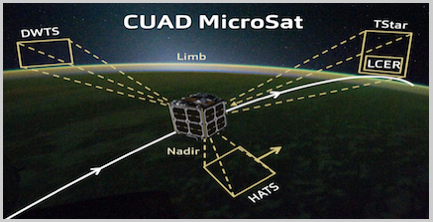
CUAD: Constellation for Upper Atmosphere Dynamics - The dynamical coupling of lower to upper atmosphere has become an intense research topic. It is now quite clear that the lower atmosphere continuously and dramatically imprints its dynamical state on the upper atmosphere in the form of winds and waves. These dense lower atmosphere systems propagate their signature into the thin upper atmosphere at increasing magnification, like tsunamis coming ashore. This produces waves and winds that, if observed, could be used not only to reveal and forecast their effects on the ITM, but help observe and forecast the evolution of lower and upper atmosphere weather, as well as upper atmosphere turbulence.
Directly observing these features from orbit is a challenge due to their small scales and rapid time evolution. Currently, sensors that view the atmosphere only through occultation or other limb observations (ex: GPS-RO and thermal imagers) are inherently limited to resolutions of 100 to 200 km or more in the horizontal. As a result, wave field observations lack time and space resolution needed for forecasting. But, these upper atmosphere signatures can now be resolved with an approach that we call Doppler Sounding with Gas Filters (DSGF), allowing observed wave and wind fields to act as powerful boundary conditions on forecast models. We know of no current or planned system that could achieve either the capabilities or the low cost of the CUAD approach.
The CUAD mission is to observe upper atmosphere dynamics on a global scale at a resolution sufficient to resolve and quantify the dynamical connection of lower to upper atmosphere. It is now possible to achieve this goal by deploying four types of small, simple, static broadband emission imagers, without the need for onboard calibration systems. These 4 imagers have unique synergistic connections that result in observations of highly resolved dynamics without on-board calibration systems.
Two of the imagers, HATS™ (High Altitude Thermal Sounder) and DWTS™ (Doppler Wind and Temperature Sounder, Gordley, 2011*), are DSGF sensors. HATS is a nadir imager and DWTS is a limb imager. The third is a simple broadband limb emission radiometer LCER™ (Limb CO2 Emission Radiometer) that provides a priori temperature profiles for HATS data analysis. The fourth is a star field limb imager, TStar™ (Temperature sounder using Star field images) that provides temperature profiles used with LCER data to develop global CO2 fields.
Each sensor sensor makes measurments that, though new in its implementation, have space heritage. A PowerPoint presentation and paper on this website provide an overview of the rigorous performance estimates that validated the CUAD concept, and review how modern detector FPAs, satellite bus ADCS, processor power and downlink bandwidth are coming together to enable this capability.
*Gordley, L. L., Benjamin T. Marshall, "Doppler Wind and Temperature Sounder: A new approach using gas filter correlation radiometry", JARS, Vol 5, 2011.
For more information
View CUAD Presentation
View CUAD Paper
|
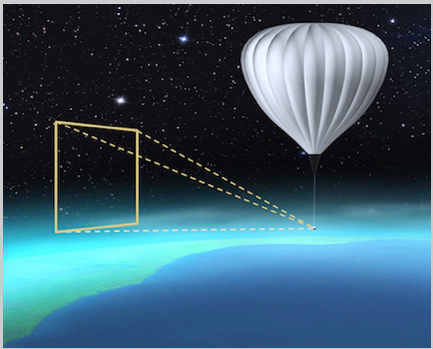
The Temperature from Star Field Imaging, T-STAR, is designed to measure temperature fields from cloud-top to the lower mesosphere by observing the star field as it sets or rises relative to an orbiting satellite carrying the sensor. T-STAR is based on the GATS Inc. patented method of using two celestial points to measure light bending angles (refraction angles) as the two points are occulted by the atmosphere. This technique is currently operational on the SOFIE solar occultation instrument aboard the AIM satellite.
For more information
View T-STAR Presentation
|
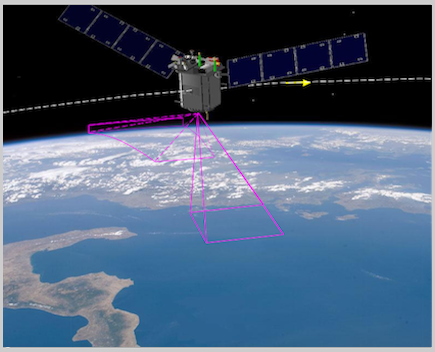 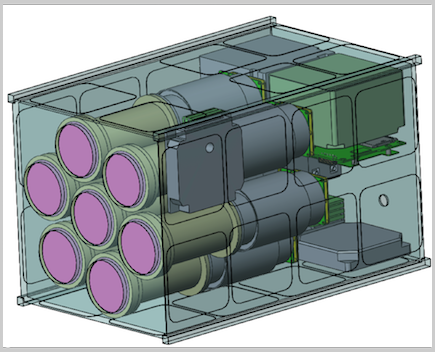
Studies indicate that this High Altitude Thermal Sounding (HATS) DSGF approach can vertically resolve gravity wave fields ‒ and all larger-scale dynamics ‒ from tropospheric cloud-top to ∼95 km, with ∼5-10 km horizontal resolution. The figure shows the observation geometry and conceptual design of a HATS instrument. HATS is the primary dynamics sounder for the CUAD system.
|
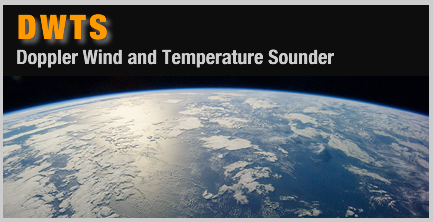
The Doppler Wind and Temperature Sounder, DWTS, is a patented satellite instrument concept for global sounding of upper-atmospheric winds and temperatures. A small constellation of DWTS microsats will provide wind and temperature fields from 15 to 250 km globally on a daily basis. These measurements are predicted to significantly improve medium to long-range weather forecast skill and enable comprehensive thermospheric weather prediction. Using the well-known gas-filter correlation technique to exploit the Doppler shifts naturally seen by a limb-viewing satellite, DWTS extracts kinetic temperature and horizontal wind vectors with unprecedented precision. We are currently assembling the team that will build, launch and operate a constellation of DWTS sensors for next-generation weather and space-weather forecasting.
As of August 1 , a prototype DWTS sensor is now built and ready for lab testing.
For more information
View DWTS Tutorial
View Article
|
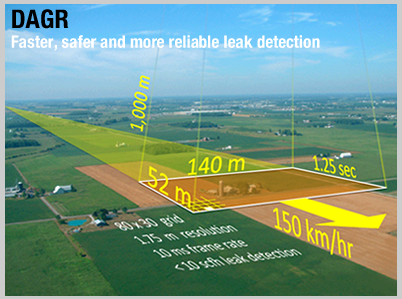 The Digital-Array Gas-correlation Radiometer, DAGR, is a breakthrough in commercial remote gas sensing. Derived from sensor technologies designed for NASA satellite-based science missions, a DAGR sensor will remotely detect even very small leaks in natural gas transmission pipelines. Our patented instrument design can produce images of methane plumes in real-time from high-flying aircraft, allowing faster and more reliable leak detection than anything currently available. Handheld versions can be configured with an active light source for use in short-range residential and urban applications. GATS plans to team with industry partner ABB to build, integrate and maintain these sensors in North America in the coming year. |
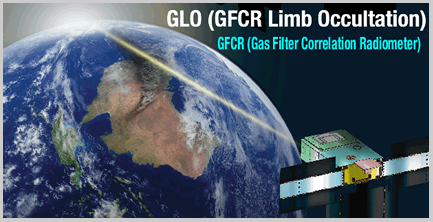 The GFCR (Gas-Filter Correlation Radiometer) Limb Occultation sensor, or GLO, is a small, sensitive satellite instrument for measuring atmospheric trace gases. Using a technique called solar occultation, an orbiting GLO sensor stares at the Sun as it rises or sets through the atmosphere at 30 different global locations each day. GLO can be configured to sense a long list of candidate gases, including water vapor, methane, carbon dioxide, carbon monoxide, nitrous oxide and many others. The simplicity, sensitivity and small-size of these extraordinary instruments makes them ideal as add-on payloads for any research or commercial satellite. A small constellation of GLO cubesats would provide comprehensive monitoring of key constituents in the Earth’s atmosphere. GLO is currently proposed for a demonstration flight under the NASA InVEST program in collaboration with Virginia Tech, the Naval Research Laboratory, and the Space Dynamics Laboratory. |
